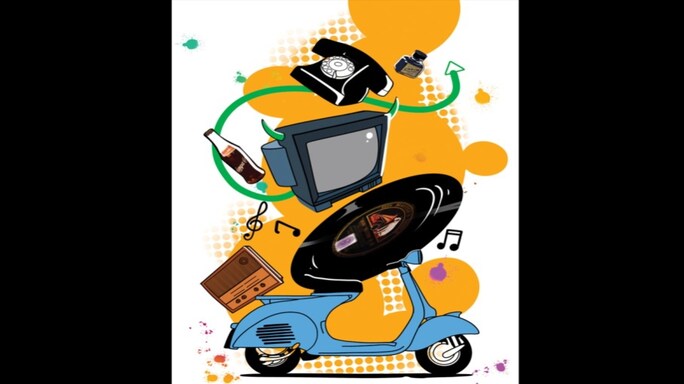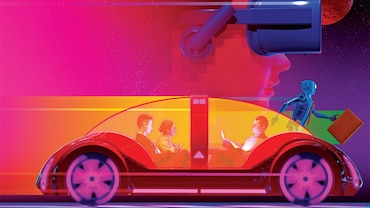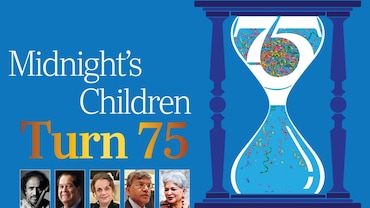- HOME
- /
- Cover Story
- /
THE THINGS THAT MAKE US INDIAN
The story of some of India’s favourite products can trace the history of our nation’s evolution
 illustrations by Siddhant Jumde
illustrations by Siddhant Jumde
Wilson Pens (1941–1988)It was a thick, orange nib that madeWilson pens popular in colleges andschools, but Dr Babsaheb Ambedkaris said to have used it to write ourConstitution because of its solidswadeshi credentials.Camlin Geometry Box (1931–)G. P. and D. P. Dandekar stole the name‘Camel’ from a box of cigarettes whengiving their stationery business a name in1931. By 1958, they settled on the moreunique ‘Camlin’ for their geometry sets.Nataraj Pencils (1958—)Made by Hindustan Pencils, the sturdyNataraj 621 HB pencil barely needed anymarketing to become popular. If you’vebeen a student in India, you know noother pencil lasts longer than Nataraj.Objects, though inanimate, can sometimes tell our story better than we can. Gandhi’s charkha, for instance, is a testament to both the Mahatma’s simplicity and his power to disrupt. From the Amul butter we spread on our toast, to the Bajaj scooter we rode in the 80s, everyday objects—ordinary, sometimes extraordinary, things—have guided our habits and our lives. They have brought us delight, comfort, even emancipation. Our identity, we see, is coded, in part, in our shopping list. As independent India turns 75, we celebrate the things that have been loyal companions in our freedom.
HOW WE COMMUNICATED
Godrej Typewriter (1955–2011)
By 1947, Godrej had already built for itself a solid reputation. Founded in 1897, the company’s popular soaps were free of animal fat; its lockers and steel almirahs had also proven to be sturdy. A few months after Independence, Pirojsha Godrej was visibly excited when his son, Naval, proposed they start manufacturing typewriters. As Pirojsha knew, they'd be the first in Asia to do this. Having cornered the Indian market, the Remington typewriter had already ushered in new modernity by having mechanised writing, making it faster and universally legible. Women, too, had started joining the workforce as typists, but the M-9, Godrej’s “all Indian” typewriter, first introduced in 1955, earned vast appeal and was hailed by PM Jawaharlal Nehru as the symbol of an “independent and industrialised” India. Here was “today’s typewriter with a touch of tomorrow”.By 1970, the year in which Shashi Kapoor frolicked to ‘Typewriter TipTip’ in Bombay Talkies, the company was manufacturing 25,000 typewriters every year. Though there were quieter imported machines on offer, Indiamuch preferred the loud, clickety-clack of a Godrej. In 2011, when Godrej shut down its typewriter unit in Pune, writers and journalists wrote mournful obituaries. The tool was obsolete, but the Godrej typewriter continues to remain beloved.
 Typewriter
Typewriter
ITI Rotary Phones(1948—circa 1980)
After World War 2, when British companies stopped supplying phones to India, the Nehru government set up Indian Telephone Industries Limited in Bangalore(ITI) to manufacture its own rotary phones.
VSNL Dial-up Modem(1995—2008)
It’s hard to forget the screeching, gargling sounds these modems made when logging on to the internet. Even harder to forget those intermittent beeps we heard before being suddenly disconnected. Airtel SIM Card (1995—)Given our need for telephony and our hunger for the internet, we’d be lost without the SIM card. No wonder then that over 350 million Indians bought into Airtel’s promise of ‘aisi azadi aur kahan?’(where else is there freedom like this?).
WHAT WE RODE
Bajaj Chetak(1972–2006)
Both a marker and means of mobility in the 1970s and 80s, the Bajaj Chetak was the steed of choice for most of middle-class India. It all started in 1959, when Bajaj won a contract to manufacture two-wheelers. The Bajaj Chetak, launched in 1972 and modelled on Piaggio’s Vespa Sprintscooter, became a blockbuster hit and the first family vehicle in several homes across the country India transformed this two-wheeler into a domesticated beast of burden—its floorboard bore the weight of entire families while still providing enough space to take on groceries and a dickey to store sundry items. Unlike the butch architecture of the motorbike that gave off adventurous, racy energy, the Chetak’s soft, rounded contours offered the functionality of motorized transport, along with a reputation for stability and safety—however unsubstantiated, since its small wheel size made it less stable than the motorcycle. Often enough, it would require a persuasive kick or vigorous tilting to get it started, but for an India of modest means, it was a vehicle that mirrored its unassuming way of life. It was after all ‘Hamara Bajaj’ (Our Bajaj)
 Scooter
Scooter
Hero Cycles (1944–)
These swadeshi workhorses that provided mobility to a newly independent, ambitious India can still be seen on Indian roads—whether it’s the milkman riding a Hero with his cans affixed to the carrier, or the odd biking enthusiast laying claim to the road.HM Ambassador (1958-2014)This burly diesel car was the answer to all of India’s automobile-related tasks—potholed roads, space to squeeze in extended family, fuel efficiency and easy to fix! A ‘laalbati’ (red light) fixed atop would transform it into a political totem. After his trusted Ambassador broke down on him in 2003, Atal Bihari Vajpayee became the first Indian PMto switch to a fully-armoured BMW. For Ambassadors, the end was nigh.
Maruti 800 (1983-2014)
Few were willing to give ‘the people’s car’ a chance against the reigning ambassador and Premier Padmini when it launched, but by the early1990s, its demand outstripped supply to such an extent that Maruti was forced to institute a “priority queue”. Politicians, of course, tried jumping that queue often.
HOW WE STUDIED
Sulekha Ink (1934–)
It isn’t often that the story of a single brand is analogous to the history of an entire nation, but Sulekha Inks, one could argue, tells perfectly that chequered tale of Indian progress. Mahatma Gandhi’s insistence on Swadeshiwas in no way half-hearted. He even wanted Indians to make the ink with which he wrote his countless letters and petitions. Nanigopal and Sankaracharya Maitra— brothers from Rajshahi(now in Bangladesh)—said they were up to the task. Legend has it that it was the prolific Rabindranath Tagore who'd given their ink both his blessing and its name—‘Sulekha’ (beautiful writing). For children who went to school in the 1950s, memories of blotting paper, dripping fountain pens and Sulekha ink are still clearly etched. While MorarjiDesai and Dr. Bidhan Chandra Royextolled Sulekha’s double-filtered virtues, Satyajit Ray doffed his hat to the ink in his films and Feluda stories. Not just did Sulekha start exporting its inks to the Middle East, it also helped the UN set up factories in Africa. The dream, sadly, was too sweet to last forever. Crippled by union trouble, Sulekha shut shop in 1988.In 2005, the West Bengal government helped resurrect Sulekha. Having flirted with home-care for some years, the company made a decisive return to its forte—inks—in November 2020. Selling the idea that fountain pens are a more sustainable option, the new line of inks—Swadeshi, Swaraj, Swadhin—stoked nostalgia, while also catching up with the ‘Made in India’ programme.
 Inkpot
Inkpot
Wilson Pens (1941–1988)
It was a thick, orange nib that made Wilson pens popular in colleges and schools, but Dr. Babsaheb Ambedkaris said to have used it to write our constitution because of its solid swadeshi credentials.
Camlin Geometry Box (1931–)
G. P. and D. P. Dandekar stole the name‘Camel’ from a box of cigarettes when giving their stationery business a name in1931. By 1958, they settled on the more unique ‘Camlin’ for their geometry sets.
Nataraj Pencils (1958—)
Made by Hindustan Pencils, the sturdyNataraj 621 HB pencil barely needed any marketing to become popular. If you've been a student in India, you know no other pencil lasts longer than Nataraj.
HOW WE WERE DRESSED
Singer Sewing Machines (1851–)
Having patented his design for the sewing machine in 1851, Isaac Singer decided to go multinational. Convinced that his sewing machine would find customers only in Europe, he had no hope from the Indian market. Little did he know that he would one day find an ambassador in Mahatma Gandhi. Though Gandhi hated machines—he felt they atrophied human limbs—he made an exception for Singer: “It’s one of the few useful things ever invented, and there is a romance about the device itself,” he said.Isaac Singer went down in history as a greedy shark, (“I don’t care a damn for the invention. The dimes are what I'm after,” TIME quotes him as saying) but Gandhi was right. Singer offered its buyers great value for money through reduced time, easy labour and creative control. In independent India, tailors sat with Singers in little rooms, or even on pavements, to herald one fashion revolution after another. From the 1920s, women had become Singer’sprincipal users, and films often hinted at the agency these machines afford. In Mera Naam Joker (1970), for instance, a widow uses a sewing machine to save her son from the circus and her family from penury.
By the 1960s, Singer, the American parent company, had started giving upon the sewing machine, but India still wanted more. With the incorporation of singer India in 1977, the country’s love for sewing machines solidified itself as a reliance. Orders, one hears, are still pouring in—from Kashmir to Kerala.
 Sewing machine
Sewing machine
Bata Footwear (1932–)
Travelling through India in the 1920s, the Czechoslovakian Tomas Bata saw in a barefooted India a ready market for his light, budget shoes. It has been 90 years and Bata is yet to give up that ‘foothold’.
Vimal Fabrics (1966–2014)
Endorsers like Sridevi, Ravi Shastri and Vivian Richards made Vimal synonymous with style, but it was Dhirubhai Ambani’sperseverance which made us think that if we need fabric, there was ‘Only Vimal’.
Flying Machine Jeans (1980–)
If video killed the radio star, it was denim jeans that killed the socialist pyjama. We had Levi’s and Wrangler,yes, but it was this Arvind Mills product which decisively helped us graduate from stodgy to stylish.
HOW WE RELAXED
Onida Colour TV (1981–)
The year was 1982. Scores of Indians huddled spellbound in front of television sets as the 16-day sporting spectacular of the ninth Asian Games unfolded in living colour. Since owning a TV set was still prohibitively expensive—and a colour one a rarity—affluent neighbours opened up their living rooms, or lent their sets to community viewing areas. Nearly 23 years after television screens first blinked to life in India, electronic colour vaulted into our homes, kickstarting the era of small-screen programming. The country shared in cataclysmic moments unfolding on-screen: Kapil Dev lifting theWorld Cup in 1983, cosmonaut Rakesh Sharma orbiting in space, patriotically proclaiming that India was ‘saare jahanse accha’ (finest in the world), or the pantheon of Hindu gods coming alive every Sunday. By then, India had exploded a nuclear device, launched satellites into orbit and had the world’s third-largest pool of scientific and technical manpower. Her autocratic ambitions electorally forgiven, Indira Gandhi, now back in power, used the Games to showcase an advancing India to the world. Neighbours Bangladesh, Sri Lanka and rival Pakistan already had colour television(CTV)—surely India couldn’t lag behind! Brand Onida emerged around the same time. Its smarmy devil mascot and seductive tagline—‘neighbour’s envy, owner’s pride’—struck a chord among consumers, allowing it to beat brands like Oscar, Salora, BPL and Videocon. Precious and aspirational, millennials may recall behemoth CTVs occupying prime real estate in drawing rooms, protectively wrapped in ‘TV covers’
 TV Set
TV Set
Murphy Radio (1948–)
Before video killed the radio, Murphyradio sets went from helping British ArmedForces communicate during World War 2to bringing everything from news to Binaca Geetmala countdown into Indian homes.
HMV Records (1901–2000)
HMV Records produced India’s first recorded song in 1903, laying the ground for the Indian music industry. As tastes and tech changed, it was acquired by the RPGGroup in the 1980s and rebranded asSaregama India Limited in 2000, sounding the closing note of its 100-year journey.
Amar Chitra Katha (1967—)
One isn’t sure if our beloved Anant Pai— considered comic books pure entertainment or an instructional moral tool, but his two creations—Amar Chitra Katha and Tinkle—made both the god Shiva and Shikari Shambhu equally fun.
WHAT WE ATE
Amul Butter (1946–)
It is hard for the youth of India to think of a butter that isn’t Amul, but for some senior citizens, the mention of Polson’s still triggers nostalgia. Polson’s was creamier, yes, but its practices were accused of being monopolistic. Farmers claimed they were being milked dry. Formed as part of a cooperative movement, Amul challenged Polson’shegemony in the beginning, but, finally, it was that tubby little doe-eyed mascot in a polka-dot dress who captured our imagination with her clever, incessant puns in 1966. By making the phrase utterly butterly’ a key part of our food lexicon, the Amul girl slid on to ourselves, seemingly forever. Indian food—of which dishes like bun maska and butter chicken are worthy ambassadors—has always needed a few good dollops of rich, salty butter. While Amul’s contribution to our culinary evolution is, of course, unmistakable, it was also Amul’s architect, Dr. Verghese Kurien, who was one of the first to show that success didn’t have to just mean profit—that self-sufficiency need nothing only on capitalism. Kurien, known as the ‘Milkman of India’, knew he had to be dogged to realize his 'Billion-Litre Dream’.By the time he passed in 2012, he had used his industry to ensure that India did not ever have to import milk or butter. That Amul butter is now sold in over 50 countries is a testament to his rigour.
 India's all-time favourite breakfast spread
India's all-time favourite breakfast spread
Parle-G (1929–)
Parle claims that if we stack the one billion packets of Parle-G biscuits it produces every month, the pile would be high enough to touch the moon. No wonder then that the ‘G’ now stands for ‘genius’.
Campa Cola (1977–)
Having introduced us to Coca-Cola in1949, the Pure Drinks Group (PDG) sipped sweet success. In 1977, when Coke was shown the door, PDG only needed to tweak its soft drink template to give us our beloved, all-desi Campa Cola.
Haldiram’s Bhujia (1937–)
Today, Hadliram’s is the world’s second-largest snack food company but its enterprise was apparent in 1937 too, when Haldiram Agarwal used his aunt’s recipe to spice up the once-humble Marwari bhujia.
HOW WE HEALED
Boroline (1929–)
Gour Mohun Dutta, one of pre-independent India’s early entrepreneurs, had made his peace with the tyranny of the British by importing cosmetics from them. In1905, when Bengal was divided and the Swadeshi project began to take off, Dutta knew he had to go local. Itwas a hand-held churner that did thetrick. Dutta used it to mix boric acid, zinc oxide, and lanolin. He called the resultant cream Boroline. Though Dutta had imagined a wider catalogue when he launched his G. D. Pharmaceuticals in 1929,it soon became clear that Borolinewas his golden goose. Given the reports he received from customers, especially those from Bengal, the antiseptic cream healed cuts, cracks, burns, swelling, even pimples. The adage went that there was only one thing Boroline couldn’t fix—a broken heart. On 15 August 1947, Dutta gave to one lakh Indians something priceless with their freedom—a free tube of Boroline. Though Boroline became a fixture in Kolkata households, there was also evidence that it had helped soldiers in the Himalayas fight frostbite. In South India, Boroline has earned the reputation of being a reliable sunscreen. One isn’t sure whether it's the green of its tube, or its trademark scent, but the unanimous verdict is simple: Nothing works like “shurobhito (fragrant) antiseptic cream, Boroline."
 Bengali 'anti-septic' cream that became a nation's obsession
Bengali 'anti-septic' cream that became a nation's obsession
Amrutanjan Balm (1893–)
Amrutanjan may never have taken off if notfor Nageswara Rao’s brilliant marketing.Knowing that music recitals leave one sore, he began selling his analgesic balm to savants outside concert halls.
Vicco Vajradanti (1952–)
We might remember the iconic advertising more than the product, but for diabetics and vegans, this toothpaste is something of a god-send. Not only is it free of sugar,it is also free of all animal products.
Dabur Hajmola(1978–)
On the subject of whether Hajmola is a digestive or a tablet full of chatpata fun,Dabur never came clean. In households that stocked its bottles, kids learnt early import of ‘too much of a good thing’.
HOW WE WERE GOVERN
EVM Machines (1980–)
For the world’s largest democracy, elections are a high-octane affair. A billion-strong population exercising their franchise—the only way to register one’s political will on the body politic—had become an increasingly expensive exercise. The paper-ballot system was not without its problems: It commandeered massive resources and was often subject to violent booth capture. Enter the Electronic Voting Machine (EVM). Invented by M B. Haneefa in 1980, this inexpensive gadget was designed to work around the geographical and socio-cultural realities of India. From the frigid Himalayan air to soaring desert temperatures, from power absences in remote polling stations to tech illiteracy of disadvantaged groups, these Braille-compatible machines ticked all the boxes, including registering no more than 300 votes an hour, which kept voter fraud in check. Upon its 1981 debut in 50 polling stations during theNorth Paravur Assembly Constituency by-election in Kerala, the EVM was dragged to the Supreme Court. the election Commission was accused of overstepping by changing the way polls are held. It took 1988 amendment to the Representation of the PeopleAct 1951, its clearance by the ElectoralReforms Committee in 1990, and a trial roll-out in 2003 state elections for EVMsto finally be allowed in the 2004 general elections. In India, the voting experience, unlike many other aspects of public life, isn’t pockmarked by hierarchies of caste and class. Every registered voter queues up in the order they arrive and exercise their vote. The EVM—helps preserve this egalitarian democratic process.
 Vote-casting device
Vote-casting device
PAN card (1972–)
The PAN card wasn’t mandatory when it first rolled out in 1972, neither was it a ‘permanent number. Each circle was provided a set of numbers, so if taxpayers changed his address, so did his PAN.
Aadhar Card (2009–)
Word to the wise: your data is more valuable than you think, and subject to breach even with a gatekeeper government. Remember the 2017 hack that led to more than 200 central and state government websites making privateAadhaar details publicly available? Or the time the official Twitter handle of Common Services Centres tweeted out Mahendra Singh Dhoni’s Aadhar info?
Co-WIN App (2021–)
As the nationwide COVID-19 vaccination drive for all adults took off in May 2021, the Co-WIN app—built to help citizens book appointments—became the next must-have download for anyone with a smartphone.






